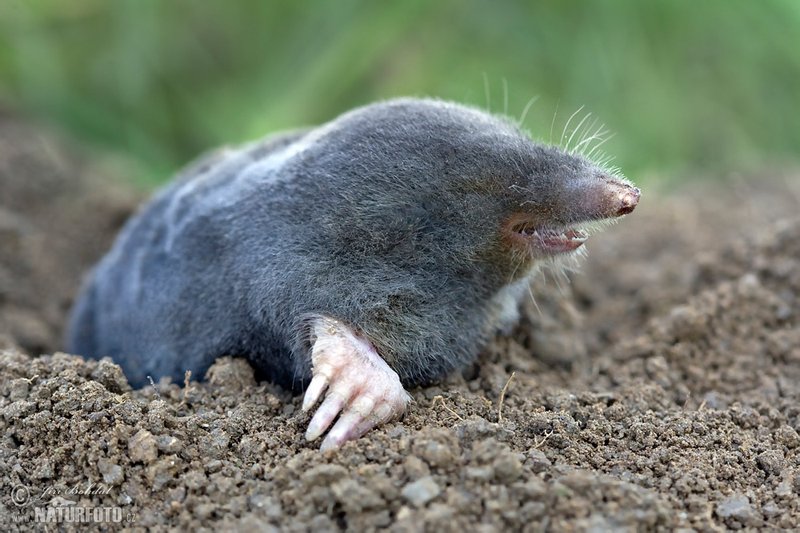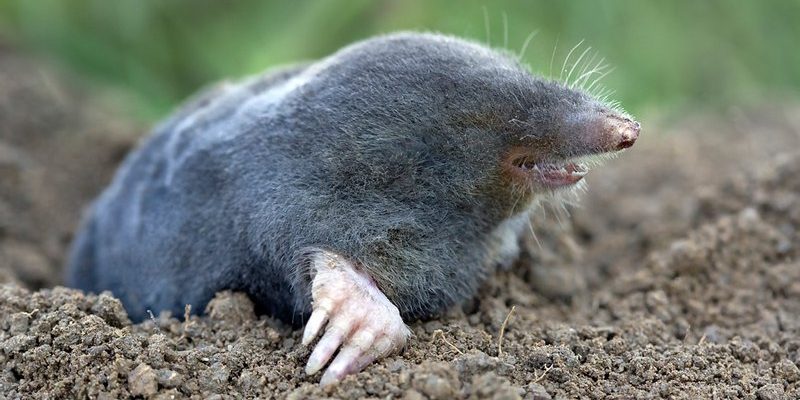
If you’ve ever seen little mounds of soil popping up in your garden, you might wonder who’s responsible for that. More than likely, it’s the industrious European Mole (Talpa europaea). These fascinating creatures spend most of their lives beneath the surface, digging elaborate tunnel systems that can stretch for miles. Think of them as miniature construction workers of the animal kingdom, tirelessly working away just out of sight.
But what makes the European Mole truly interesting? They are not just soil movers; they play a crucial role in the ecosystem. Their burrowing helps aerate the soil, and they also control insect populations. So, the next time you see a molehill, remember that there’s a lot more going on underground than meets the eye. Let’s dive deeper into the life of these elusive animals!
Physical Characteristics
The European Mole is a small creature, typically measuring about 4 to 7 inches in length, excluding its tail. They have a stocky body covered in velvety fur that ranges from dark brown to black, helping them blend seamlessly into their underground habitat. Their eyes are tiny and almost hidden under fur, which is perfect for their subterranean lifestyle. After all, why would they need big, bright eyes when they spend most of their life in the dark?
One of the most distinctive features of the European Mole is its large, spade-like front paws. These paws are specifically adapted for digging, giving them incredible strength. Imagine using a tiny shovel to burrow through dirt—now, that’s some serious effort! Their sharp claws allow them to move quickly through the soil, creating extensive tunnel networks.
Another interesting trait is their long, pointed snout. This helps them to sense their surroundings and locate food, even in complete darkness. They have a rich supply of whiskers that serve as additional sensory tools, helping them navigate their underground realm. With all these adaptations, it’s clear that the European Mole is built for life beneath the earth.
Habitat and Range
The European Mole is primarily found across Europe, from the United Kingdom to Scandinavia and down to the Mediterranean regions. They thrive in a variety of habitats, including grasslands, forests, and even urban areas. However, they prefer moist, loamy soils rich in earthworms and insects, which are their primary food sources.
Being a fossorial animal, the European Mole is perfectly adapted to life underground. They dig extensive tunnel systems that can reach depths of up to 3 feet, allowing them to evade predators and find food sources effectively. These tunnels can stretch over several hundred meters, making them quite the underground engineers.
Interestingly, European Moles are solitary creatures and rarely come to the surface unless absolutely necessary. They create separate living and feeding tunnels, ensuring that their nests are undisturbed. This lifestyle is part of what makes their habitat so fascinating—each tunnel is like a network of hidden highways, bustling with activity just below our feet.
Diet and Feeding Habits
The diet of the European Mole primarily consists of earthworms, which make up about 80% of their food intake. They have an impressive sense of smell that helps them locate these wriggly invertebrates beneath the soil. They can consume a significant number of earthworms daily—sometimes as many as 50! How do they do this? Their high metabolic rate requires them to eat continuously, so they are often on the hunt.
Besides earthworms, European Moles also eat other soil-dwelling creatures like insects and larvae. They’re not picky eaters, taking advantage of whatever is available in their underground paradise. This diverse diet plays a crucial role in controlling insect populations, helping maintain the balance of their ecosystem.
Another interesting aspect of their feeding habits is that they will often store food in their tunnels. If they’ve had a particularly good day hunting, they might stash some worms for later, sort of like a little underground pantry. This not only ensures they won’t go hungry but also helps in maintaining a steady supply of nutrients in their habitat.
Reproduction and Lifespan
When it comes to reproduction, the European Mole has a relatively simple but intriguing process. Breeding typically occurs from February to June, and after a gestation period of about 4 weeks, the female gives birth to a litter of 2 to 7 pups. These little moles are born blind and hairless, requiring significant care from their mother for the first few weeks of life.
Young moles grow rapidly, and within a month, they start venturing out of the nest. By the time they are around 2 months old, they’re usually independent and ready to dig their own tunnels. This rapid maturation is crucial as it allows the population to stabilize despite various threats from predators.
The lifespan of a European Mole is generally around 3 to 6 years in the wild, although some can live longer if they avoid predators and disease. Their solitary nature means they often have fewer threats, but they still face dangers from animals like foxes and birds of prey. This natural cycle of life is all part of what makes the European Mole a vital component of its ecosystem.
| Characteristic | Details |
|---|---|
| Size | 4 to 7 inches (excluding tail) |
| Habitat | Moist, loamy soils across Europe |
| Diet | Mainly earthworms, insects, and larvae |
| Life Span | 3 to 6 years in the wild |
| Reproduction | 2 to 7 pups per litter |
| Adaptations | Powerful front paws for digging |
Behavior and Social Structure
The European Mole is primarily a solitary animal. They spend most of their lives alone, except during the breeding season. Each mole establishes its territory, which it defends fiercely against others. You might wonder how they even know where their territory begins and ends. Well, they use scent markings and physical barriers, like their extensive tunnels, to communicate with others nearby.
In terms of behavior, these moles are incredibly industrious. They can dig at an impressive rate, often moving up to 6 meters in an hour. Imagine working tirelessly underground with tools that can excavate dirt as if it were sand! Their relentless digging serves not only to build homes but also to hunt for food.
You might think that living underground would limit social interaction, but they do have some ways of communicating. They use a variety of sounds and vibrations to signal others. When a mole feels threatened, it may produce a series of warning snorts to alert nearby moles. It’s a delicate balance of living alone yet still being aware of fellow moles in the area.
Conservation Status
Currently, the European Mole is classified as a species of “Least Concern” by the International Union for Conservation of Nature (IUCN). This means that, overall, they are not considered at risk of extinction. However, certain threats exist that can impact their populations. Urbanization and agricultural practices often destroy their natural habitats, leading to a decline in the areas where they can live and thrive.
Additionally, the use of pesticides can reduce their food supply, as these chemicals may kill their primary prey—earthworms and insects. It’s kind of a double-edged sword; while farmers may seek to protect crops, this can create a ripple effect in the ecosystem. The reduction of European Moles could lead to increased insect populations, further disrupting the natural balance.
Conservation efforts focus on habitat preservation and responsible land-use practices that allow moles and other wildlife to coexist with human activities. Educating the public about the importance of these little creatures can help promote a greater understanding and appreciation for their role in the ecosystem.
FAQ
What do European Moles look like?
European Moles are small, stocky animals covered in velvety fur. They typically range in size from 4 to 7 inches long (not including the tail). Their eyes are tiny and barely visible, as they primarily live underground where vision isn’t as useful. Their large, spade-like front paws are adapted for digging, making them excellent burrowers.
Where do European Moles live?
These moles are found throughout Europe, from the UK to Scandinavia and southern Europe. They prefer moist, loamy soils where they can easily find their primary food sources—earthworms and insects. While they can adapt to various environments, they do best in areas rich in organic matter.
How fast can European Moles dig?
European Moles are impressive diggers, capable of moving around 6 meters (20 feet) of soil in just one hour! Their powerful claws and strong forelimbs allow them to create complex tunnel systems quickly and effectively.
Do European Moles have any predators?
Yes, European Moles face a few natural predators, including foxes, hawks, and badgers. While their underground lifestyle offers some protection, they are still vulnerable to being caught by these animals when they come to the surface or while digging their burrows.
How do European Moles communicate?
Even though European Moles are mostly solitary, they do have ways of communicating with one another. They use a range of sounds, such as snorts and chirps, mainly to signal warnings or territory boundaries. Their keen sense of smell is also crucial for communication through scent marking.
Can European Moles be kept as pets?
While it might be tempting to think about keeping a European Mole as a pet, they are not suitable for domestication. Their specialized diet and digging habits make them challenging to care for. Plus, they thrive in their natural habitat, where they play an essential role in the ecosystem.
Are European Moles beneficial for gardens?
Surprisingly, yes! Despite their burrowing habits, European Moles can be beneficial for gardens. Their digging aerates the soil and helps improve drainage, while their diet helps control insect populations. Instead of seeing them as pests, consider them your garden’s little helpers!
What do European Moles eat?
European Moles primarily feed on earthworms, which make up a significant portion of their diet. They also consume insects, larvae, and other soil-dwelling organisms. Their ability to find and consume large quantities of earthworms is vital for their survival and the health of their ecosystems.
How do European Moles reproduce?
Breeding typically occurs between February and June. After a gestation period of about four weeks, the female European Mole gives birth to a litter of 2 to 7 pups. These young moles grow quickly and become independent within two months.
What threats do European Moles face?
Though they are currently not endangered, European Moles face threats from habitat loss due to urbanization and agricultural practices. Pesticide use can also deplete their food sources, impacting their populations. Awareness and conservation efforts are essential to protect these animals and their habitats.
How long do European Moles live?
In the wild, European Moles typically live for about 3 to 6 years. Some may live longer if they manage to escape predators and disease. Their solitary nature and effective burrowing skills can help them avoid many dangers.
Are European Moles solitary animals?
Yes, European Moles are primarily solitary creatures. They spend most of their lives alone and establish their own territories, which they defend against other moles. The only time they come together is during the breeding season.

